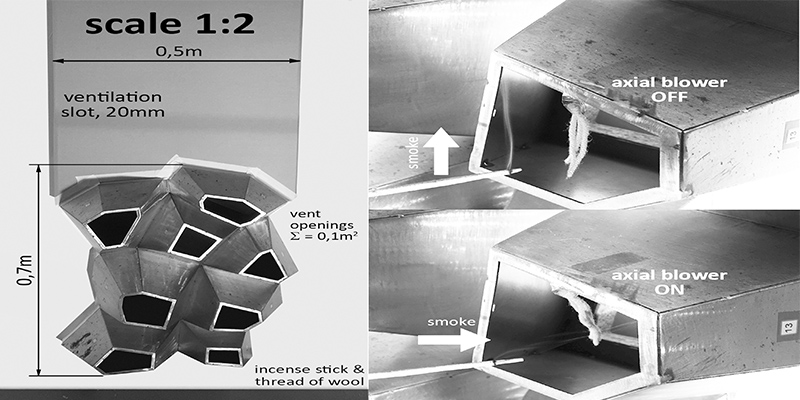Downloads
DOI:
https://doi.org/10.7480/jfde.2016.3-4.1166Keywords:
greened cooling cladding, urbanisation, climate change, greening of claddings, architectural bionicsAbstract
This paper deals with the greening of claddings and the cooling of buildings from the perspective of a bionic scientist or an industrial designer. Reflections on a new building cover shall early enough show an approach to the containment of future problems in the often predicted ‘urban future’. The development of a concept for a greened cooling cladding happens through the transition of bionic-mathematical principles, which have been considered only a little here so far. The paper begins with a summary of the public debate about the topics urbanization and climate change. The section 'greening of claddings' shall illustrate a smarter, future-orientated idea for the building sector. The section of architectural bionics shows the potentials of nature’s principles of construction, originating millions of years ago, and it analyses relevant bionic principles in full detail. To conclude, the author’s iterative concept development for a bionically-mathematically inspired, greened cooling cladding is explained and the obtained findings are discussed. In addition, further development potentials are considered.
How to Cite
Published
Issue
Section
License
Copyright (c) 2016 Michael Johann Paar, Alexander Petutschnigg

This work is licensed under a Creative Commons Attribution 4.0 International License.
Authors or their institutions retain copyright to their publications without restrictions.
References
Aurenhammer, F. (1991). Voronoi diagrams – a survey of a fundamental geometric data structure. ACM Computing Surveys Journal 23, Issue 3.
Bahadori, M. N. (1994). Viability of wind towers in achieving summer comfort in the hot arid regions of the middle east. Journal of Renewable Energy 5, Issues 5–8.
Bauer, S. & Mösle, P. & Schwarz, M. (2013). Green Building. Leitfaden für nachhaltiges Bauen (2nd ed.). Berlin Heidelberg: Springer-Verlag.
Bass, B. & Martens, R. & Alcazar, S. S. (2008). Roof–envelope ratio impact on green roof energy performance. Urban Ecosystems Journal 11, Issue 4.
Bertness, M. D. et al. (1992). Components of recruitment in populations of the acorn barnacle Semibalanus balanoides (Linnaeus). Journal of Experimental Marine Biology and Ecology 156, Issue 2.
Dunnett, N. & Kingsbury, N. (2008). Planting green roofs and living walls. Portland: Timber Press.
Hupfer, P. & Kuttler, W. (eds.) (2005). Witterung und Klima. Eine Einführung in die Meteorologie und Klimatologie (11th ed.). Wiesbaden: B. G. Teubner Verlag.
Köhler, M. (ed.) (2012). Handbuch Bauwerksbegrünung. Planung – Konstruktion – Ausführung. Köln: Verlagsgesellschaft Rudolf Müller.
Korb, J. (2003). Thermoregulation and ventilation of termite mounds. The Science of Nature Journal 90, Issue 5.
Lüscher, M. (1955). Der Sauerstoffverbrauch bei Termiten und die Ventilation des Nestes bei Macrotermes natalensis. Therwil: Verlag für Recht und Gesellschaft.
McLean, W. & Silver, P. (2008): Introduction to Architectural Technology. London: Laurence King Publishers.
Meyer, H. U. & Twenhöven, F. L. & Kock, K. (1994). Lebensraum Wattenmeer. Wiesbaden: Quelle und Meyer Verlag.
Minke, G. (2010). Dächer begrünen – einfach und wirkungsvoll. Planung, Ausführungshinweise und Praxistipps (4th ed.). Staufen bei Freiburg: ökobuch Verlag.
Nachtigall, W. (2002). Bionik. Grundlagen und Beispiele für Ingenieure und Naturwissenschaftler (2nd ed.). Berlin Heidelberg: Springer-Verlag.
Nachtigall, W. & Pohl, G. (2013). Bau-Bionik. Natur – Analogien – Technik (2nd ed.). Berlin Heidelberg: Springer-Verlag.
Ottelé, M. (2011). The green building envelope: vertical greening (Doctoral dissertation). Delft: University of Delft.
Perini, K. et al. (2011). Greening the building envelope, façade greening and living wall systems. Open Journal of Ecology 1, No.1.
Riviere, P. et al. (2008). Preparatory study on the environmental performance of residential room conditioning appliances (airco and ventilation). Draft report for the European Commission.
Thies, M. (1985). Biologie des Wattenmeeres. Köln: Aulis Verlag Deubner & Co KG.
Vogel, S. & Ellington Jr., C.O. & Kilgore Jr., D.C. (1973). Wind-induced ventilation of the burrow of the prairie-dog, Cynomys ludovicianus. Journal of Comparative Physiology 85, Issue 1.
Wong, N. H. et al. (2009). Acoustics evaluation of vertical greenery systems for building walls. Journal of Building and Environment 45, Issue 2.
